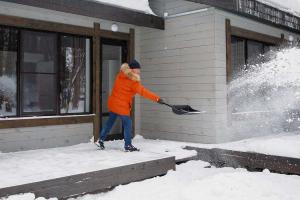Mastering the Art of Snow Shoveling: A Comprehensive Guide to Safe and Efficient Snow Removal

-
Quick Links:
- Introduction
- The Importance of Snow Removal
- Health Risks Associated with Snow Shoveling
- Tools and Equipment
- Techniques for Shoveling Snow
- Step-by-Step Guide to Shoveling Snow
- Case Studies and Expert Insights
- Snow Removal Alternatives
- Seasonal Maintenance Tips
- Conclusion
- FAQs
Introduction
When winter blankets the landscape with snow, the task of snow shoveling becomes a necessary chore for many homeowners. While it might seem straightforward, shoveling snow can pose risks, require specific techniques, and necessitate the right tools to ensure efficiency and safety. This comprehensive guide aims to equip you with everything you need to know about shoveling snow effectively and safely.
The Importance of Snow Removal
Snow removal is critical for several reasons:
- Safety: Accumulated snow can create hazardous conditions for pedestrians and vehicles.
- Property Protection: Excess snow can lead to roof damage, flooding, and foundation problems.
- Accessibility: Keeping pathways and driveways clear ensures that emergency services can access your home if needed.
Health Risks Associated with Snow Shoveling
While shoveling snow is necessary, it can also be physically demanding and even dangerous. Some of the health risks include:
- Cardiovascular Strain: Shoveling snow can lead to heart problems, especially in individuals with pre-existing conditions.
- Back Injuries: Improper shoveling techniques can result in back strains or injuries.
- Slips and Falls: Icy conditions can increase the likelihood of falls during the shoveling process.
Tools and Equipment
Choosing the right tools can make a significant difference in snow removal efficiency. Here are some essential tools:
- Shovels: Various types, including ergonomic shovels, snow pushers, and traditional shovels.
- Snow Blowers: Ideal for large areas or heavy snow accumulations.
- Ice Melt: Chemical agents to help reduce ice buildup on surfaces.
Techniques for Shoveling Snow
Effective shoveling techniques can reduce strain and improve efficiency. Consider the following:
- Push rather than Lift: Pushing snow can be less straining than lifting it.
- Use Proper Posture: Keep your back straight and bend at the knees.
- Work in Sections: Shovel small areas at a time to avoid fatigue.
Step-by-Step Guide to Shoveling Snow
Follow these steps to shovel snow efficiently:
- Assess the Conditions: Check the weather and snow depth.
- Gather Your Equipment: Ensure you have the right tools ready.
- Warm-Up: Stretch to prevent injuries.
- Start Shoveling: Begin from the edges and work towards the center.
- Take Breaks: Rest periodically to avoid overexertion.
Case Studies and Expert Insights
Experts recommend sharing experiences to illustrate the importance of proper shoveling techniques. For instance, a study by the American Heart Association found that individuals who shovel snow are at a higher risk of heart attacks, particularly those aged 55 and older. It emphasizes the need for caution and the importance of knowing one's limits.
Snow Removal Alternatives
In addition to manual shoveling, consider these alternatives:
- Hiring Professionals: Many services specialize in snow removal.
- Using a Snow Blower: For larger areas, a snow blower can save time and effort.
- Heated Driveways: An investment that can significantly reduce snow accumulation.
Seasonal Maintenance Tips
To prepare for winter and ensure effective snow removal:
- Inspect Your Tools: Ensure shovels and snow blowers are in good working condition.
- Stock Up on Supplies: Have ice melt and other snow removal supplies ready.
- Create a Snow Removal Plan: Know when and how you will remove snow after each snowfall.
Conclusion
Shoveling snow may seem like a simple task, but it requires preparation, the right techniques, and an understanding of the associated health risks. By following this comprehensive guide, you can make snow removal a safer and more efficient process, ensuring that your home remains accessible and safe during the winter months.
FAQs
- 1. How often should I shovel snow?
- It's best to shovel snow after each snowfall to prevent heavy accumulations.
- 2. What is the best time to shovel snow?
- Shoveling early in the morning can be effective, especially before temperatures rise and snow begins to melt.
- 3. Can I use a regular shovel for snow?
- Yes, but ergonomic or specialized snow shovels are designed to reduce strain.
- 4. How can I prevent back pain while shoveling?
- Use proper lifting techniques, take breaks, and consider using a snow pusher.
- 5. Is it safe for seniors to shovel snow?
- Seniors should be cautious and consider hiring help if they have health concerns.
- 6. What type of snow blower should I buy?
- Choose a snow blower based on the size of the area you need to clear and the type of snow you typically experience.
- 7. Can I use salt on my driveway to prevent ice?
- Yes, salt can help melt ice, but be cautious as it can damage concrete and harm plants.
- 8. What should I do if I injure myself while shoveling?
- Stop shoveling immediately, apply ice to the injured area, and consult a health professional if necessary.
- 9. How can I make shoveling easier?
- Consider using a snow blower or hiring a snow removal service if the workload is too much.
- 10. When should I call a professional for snow removal?
- If you have heavy snow accumulations or are unable to shovel due to health issues, it's best to hire professionals.
For more information on safe snow removal practices, check out these resources:
- American Heart Association: Winter Wellness Tips
- Centers for Disease Control and Prevention: Winter Weather
- National Safety Council: Winter Safety Tips
Random Reads